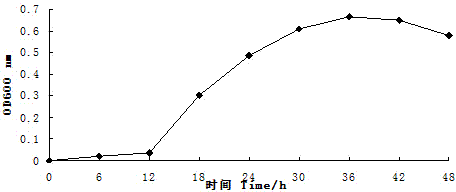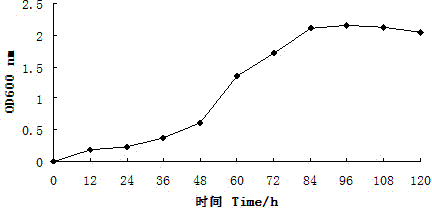Low-temperature resisting method for festuca arundinacea by using complex microbial inoculants
A technology of compound microbial bacterial agent and tall fescue, which is applied in the field of air-dried sludge bacterial agent and tall fescue anti-low temperature, and can solve rare problems
- Summary
- Abstract
- Description
- Claims
- Application Information
AI Technical Summary
Problems solved by technology
Method used
Image
Examples
Embodiment 1
[0108] (1) Cultivation of strains
[0109] Weigh fresh sludge and prepare 10 by dilution separation method -3 、10 -4 、10 -5 、10 -6 sludge suspension. According to the isolated microorganisms, take different concentrations of sludge suspension (fungi take 10 -3 、10 -4 , Actinomycetes take 10 -4 、10 -5 , bacteria take 10 -5 、10 -6 ), shake well and pipette 0.2 mL into the prepared plate. Fungi use Martin's agar plate; actinomycetes use Gao's No. 1 agar plate; bacteria use beef extract peptone plate. Spread evenly with a sterilized applicator, repeat 3 times for each treatment, and incubate at 28°C. According to the shape, size, color and growth speed of the colonies in the plate, pick as many single colonies as possible from each sample and streak for purification. The strains were classified and counted according to their colony culture traits and morphological characteristics. The dominant strains were determined and stored under serial numbers pending further ide...
Embodiment 2
[0119] A compound microbial bacterial agent is characterized in that it is made up of following composition:
[0120] 100-fold dilution of Pseudomonas stutzeri + Trichoderma reesei + Streptomyces flavum;
[0121] Wherein Pseudomonas stutzeri: Trichoderma reesei: the volume ratio of Streptomyces flavus is 1:1:1
[0122] Follow the steps below:
[0123] (1) Selection of materials:
[0124] Select tall fescue with plump and uniform grains ( Festuca arundinacea L.) The seeds are the test materials; the test soil is common garden soil;
[0125] (2) Test method
[0126] Preparation of compound microbial bacterial agent: Select Pseudomonas stutzeri, Trichoderma reesei and Streptomyces griseus, purify and culture the isolated strains for 2 generations, take the activated strains, and insert them into a container containing 200 mL of liquid medium. In a triangular flask, cultivate at a suitable temperature of 180 r / min, select 600 nm wavelength for turbidity measurement, take the...
Embodiment 3
[0133] A compound microbial bacterial agent is characterized in that it is made up of following composition:
[0134] 200-fold dilution of Pseudomonas stutzeri + Trichoderma reesei + Streptomyces flavum;
[0135] Wherein Pseudomonas stutzeri: Trichoderma reesei: the volume ratio of Streptomyces flavus is 1:1:1
[0136] Follow the steps below:
[0137] (1) Selection of materials:
[0138] Select tall fescue with plump and uniform grains ( Festuca arundinacea L.) The seeds are the test materials; the test soil is common garden soil;
[0139] (2) Test method
[0140] Preparation of compound microbial bacterial agent: Select Pseudomonas stutzeri, Trichoderma reesei and Streptomyces griseus, purify and culture the isolated strains for 2 generations, take the activated strains, and insert them into a container containing 200 mL of liquid medium. In a triangular flask, cultivate at a suitable temperature of 180 r / min, select 600 nm wavelength for turbidimetric measurement, take...
PUM
 Login to View More
Login to View More Abstract
Description
Claims
Application Information
 Login to View More
Login to View More - R&D
- Intellectual Property
- Life Sciences
- Materials
- Tech Scout
- Unparalleled Data Quality
- Higher Quality Content
- 60% Fewer Hallucinations
Browse by: Latest US Patents, China's latest patents, Technical Efficacy Thesaurus, Application Domain, Technology Topic, Popular Technical Reports.
© 2025 PatSnap. All rights reserved.Legal|Privacy policy|Modern Slavery Act Transparency Statement|Sitemap|About US| Contact US: help@patsnap.com



